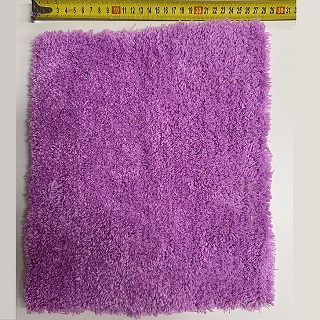How much area will 100 grams of yarn cover? How much yarn will I need?


These are the most common questions that may arise at the beginning of rug making. Watch our process video and read our short article to find the answer.
The Amount of Yarn Used in Tufting: Key Factors and Calculations
Tufting is a wonderful craft technique that allows creators to transform yarn into beautiful textiles, such as rugs or wall hangings. However, a common question often arises: "How much yarn will I need for my project?" The amount of yarn required is influenced by several factors, including the type of yarn, length, desired density, and working speed. In this blog post, we will focus on these factors and provide a detailed guide on how to accurately estimate your yarn needs.
1. Factors Influencing Yarn Usage
A. Yarn Type
The type of yarn you choose plays a significant role in your tufting project. We used 8-ply, 100% acrylic tufting yarn. The thickness of the yarn is crucial, as it determines how densely we can fill the project. A thicker yarn allows you to work with a single strand, simplifying the process and ensuring a fuller appearance in the final piece.
For example, if we were to use a thinner yarn, we might need to use multiple strands to achieve the desired density, thus increasing the amount of yarn required. When selecting your yarn, consider its weight, fiber composition, and how it behaves during tufting.
B. Cut Pile Length
The length of the cut pile is also an important factor. The distance between the machine's scissors and the needle can be measured by adjusting the gear. We have it set to 2 cm, which determines how long the cut strands will be. Longer cut strands create a denser effect, while shorter strands produce finer, more detailed textures.
C. Row Density
Row density is another key factor. We aimed for a medium density during our work, meaning that there were relatively equal distances between the rows. Denser row formation requires more yarn, while sparser row formation reduces the required amount.
D. Hand/Tufting Machine Speed
The working speed is also important, as it can vary depending on whether you are working by hand. When using a tufting machine, the machine's settings, such as speed and yarn tension, also affect the work. We worked at a medium pace, which allowed for precise and even row formation.
2. Calculating Yarn Usage
Based on these conditions, we created a rectangle measuring 31.5 cm x 26.5 cm from 100 grams of yarn, which is approximately 835 cm² and closely resembles a 29 cm x 29 cm square. This implies that our 400-gram tufting yarn, which currently costs 3890 forints, is comfortably sufficient for making a 1 square meter rug or a circular rug with a diameter of 65 cm.
This information helps in estimating the yarn quantity needed for future projects. Once we know what type of yarn we are using, the length of the cut pile we chose, and the density at which we are working, we can easily calculate how much yarn we will need.
3. Summary
As can be seen, the precise determination of yarn usage depends on several factors. The selection of the appropriate yarn type, the length of the cut pile, the density of the rows, and the working speed all contribute to the final result. With this knowledge, we can now roughly estimate how much yarn will be needed for the next project.
Tufting Tip: Thread the center of a wound yarn ball, so the machine can pull the yarn more easily.
We hope this blog post helps clarify yarn usage and encourages you to confidently dive into your next tufting project!

